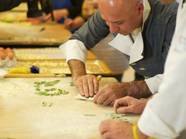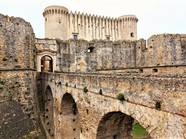The baths of the gods
...well being, a quality which tends to get trampled by the stress of daily life. Italy is rich with springs whose water is abundant in natural elements. Spa water will help you regenerate your mind and body, and attain a level of healthy living and inner serenity. We have snooped around and found ten marvelous spas with springs, natural swimming pools, and many other amenities that can transport you to a level of total bliss. The tradition of spas is well rooted in Italy: These sources of rejuvenation were already known in the days of Emperor Augustus, and many of Italy’s greatest minds took advantage of their powers, including dramatist Luigi Pirandello and composer Giuseppe Verdi. Chianciano Terme, in the province of Siena, Tuscany (www.chiancianoterme.com). This is a spa resort whose mineral water is enriched with healing elements. Situated approximately 1.800 feet above sea level, the spa offers a great climate and many advantages for tourists due to its exceptional location. The spa is blessed with mild weather and a healthy, pristine environment. Today, Chianciano offers four springs: Acqua Santa, used as refreshment while fasting, and prescribed as a cure for the liver; Acqua Fucoli, an afternoon elixir suited for gastric disturbances; Acqua Sillene, with a high content of carbon dioxide, used for the preparation of mud baths; and Acqua Santissima, rich in mineral salts and used for inhalation. Capri Palace Hotel & Spa, in Capri, Campania (www.capri-palace.com). Perched on the highest part of the island, the CapriPalace is magnificent. It features spa treatments such as anti-stress massage, body toning, hydro-massage, sauna, Turkish bath, Jacuzzi, and more. Water treatments utilize the richly fortified waters of nearby natural springs. A large physical therapy saline pool is right off the entryway of the hotel. The pool is utilized for passive physical treatments, repairing individual motor function, and recovery after physical trauma or injury. Bagni di Bormio, in Bormio, Lombardy (www.bagnidibormio.it). A vacation at Bagni di Bormio Spa Resort, in the heart of the Alps, is a unique experience that has been enjoyed for more than 2.000 years, from the time of the Romans. In its spa centers, Bagni Vecchi and Bagni Nuovi, there are more than sixty different thermal offerings, of which eleven are open-air tubs or pools. Immersion in thermal waters, maintained at a naturally hot (100° to 109°F) temperature, is alternated with relaxation in the mountain sun. The massage centers are not simply part of a health spa, but represent the culmination of a process of physical and mental regeneration. The process begins with immersion in hot thermal waters that prepare the body to receive the benefits and healing effects of an aesthetic treatment or a final massage. The hot waters promote the process of exfoliation, thanks to the suspended sulfur-bacteria (natural mud) that makes the skin smooth and velvety. Bagno Vignoni, in Tuscany (www.bagnovignoni.it). The most outstanding characteristic of Bagno Vignoni, besides its thermal waters, is its structure, which has remained unaltered through time. In fact, its piazza isn’t like any other; it is characterized by hot water, that gushes out at 125°F. The tub for the thermal waters is in fact in the center of the piazza, closed on three sides by an enclosing wall almost a five feet tall. Inside are some of the buildings, realized by Bernardo Rossellino in honor of Pope Pio II, and the open gallery where Saint Caterina of Siena visited. It’s from there, in the great tub in which Lorenzo de’ Medici (Lorenzo the Magnificent) bathed in the 16th century, that one can admire one of the region’s most splendid vistas. Masseria San Domenico Spa, in the province of Brindisi, Puglia (www.masseriasandomenico.com). Here seawater is used as the essential element of thalasso-therapy. Its salinity, rich in minerals, make it a prime source of purification for the human body. The water is drawn from deep underground, 1,300 feet below the sea. Filtered and rendered pure of bacteria, the water is reheated by the spa’s facilities that employ state of the art equipment. Another natural gift that comes from the sea is seaweed; these aquatic vegetables have concentrations of minerals and vitamins indispensable to the health of our biological functions. Broken up or pulverized, they are used with seawater in hydro-massage or for compresses. Seawater and seaweed create an exceptional cocktail that releases liberating, stress-relieving, invigorating, and detoxifying virtues. The nucleus of Masseria San Domenico was built in the 15th century and is comprised of a watchtower that belonged to the Knights of Malta, who had their main base in Puglia in the nearby port of Santo Stefano. Grotta Giusti Terme, in the province of Pistoia, Tuscany (www.grottagiustispa.com). In Monsummano, in the heart of beautiful Tuscany, rich in enchanting hills and cities of art and culture, one finds a natural masterpiece, Grotta Giusti. The thousand-year-old cave, marvelous and intact, is hidden among the carbonic rocks of the mountain that shelters it. The cave extends for over two hundred yards underground, creating labyrinths, decorated by stalactites and stalagmites and spacious caverns. At the base of the cavity there lies a crystalline mirror of hot thermal waters that emit a beneficial and therapeutic vapor. The spacious vaults in the rock form ideal rooms for natural saunas and detoxifying treatments. This exclusive pleasure is the secret that has made the Grotta Giusti famous. The pathways of the underground area are such that they create pockets with different temperatures. Proceeding from the entrance toward the deepest parts of the Grotta, one in fact crosses three temperature zones, each getting hotter and hotter, so that tradition has baptized them Heaven, Purgatory, and Hell. BoarioTerme, in the province of Brescia, Lombardy (www.termediboario.it). This ideal destination for a relaxing stay combines physical and mental well-being with bodily health in a location that is extremely interesting from a tourist's point of view. Treatments are categorized in four specific “objective programs” (that can be found together on the program), born from the collaboration between Doctors Coiro and Zanardi from the University of Parma. Their goal was to propose a mix of synergetic thermal cures, to treat in an even more effective way disturbances of the intestine, liver, joints, and blood circulation. Each program is accompanied by a series of recommendations, which are explained to clients by the doctors. The programs are designed so clients can continue to follow this advice even after they return home. This approach represents an innovative point of view, as the Terme di Boario isn’t only designed as a place of curing, but also as a guide to better health all year round. The Terme di Boario also boasts “Relax&Beauty,” its center of well being which, from July 2005, has included an innovative service of aesthetic medicine. Hotel Continental Terme, Ischia, in Campania (www.continentalterme.it). This oasis of comfort and beauty is tucked away inside the island of Ischia. Five thermal pools of various sizes and temperatures (82° to 98°F) are harmoniously set among the green and exotic flowers of the garden. From its volcanic origins, the island of Ischia is extremely rich in thermal-mineral springs that have made it, from the 7th century, a famous source of thermal cures. A basin of thermal-mineral waters of particular interest is the one situated in the Fondo Bosso area, where the Hotel Continental Terme is situated. At Club Benessere spa, the curative effects of the thermal waters are integrated with the most modern techniques in massage, physical therapy, and aesthetic medicine to restore health or to enhance beauty. The therapeutic program is practiced and personalized by a team of specialists. Abano Terme, in the province of Prodenone, in Veneto (www.abanoterme.net). Abano currently boasts 78 thermal hotels, 120 pools, 50 tennis courts, parks and gardens, and services of the highest quality in the field of thermal cures. It combines these resources with aesthetic cures and fitness, to regenerate the body in all of its aspects. The city’s claim to fame, its thermal water and mud, are practically unique in their therapeutic properties. Known and exploited since Roman times 2.000 years ago, the spa’s thermal water has only recently revealed its secret. In-depth studies conducted by the University of Padova and the Centro Studi Termali Pietro D’Abano have established that the layers of thermal water present in the subsoil of the entire area are from the precipitation of the Pre-Alps, in particular from the Lessini Mountains above Verona. To complete this subterranean journey of almost 60 miles and arrive in the Euganean area, the water takes an estimated time of 25 to 30 years, in the course of which it is enriched with dozens of different mineral salts. The chemical composition if the water is extremely important. When it’s added to the mud, it’s ready to begin its therapeutic actions against the scope of rheumatic illnesses, osteoarthritis, joint pains, trauma, and fractures, not to mention maladies of the respiratory system. Terme di Saturnia (Saturnia Thermal Baths), province of Grosseto, Tuscany (www.termedisaturnia.com). The sulfuric water of this region rises from underground at a rate of more than 200 gallons a second and a constant temperature of 98°F. Rich in bicarbonate and sulfates, the water has health-stimulating properties, effective for the skin, the respiratory system, and the skeletal system.





































Comments
1
1
1
1
1
1
1
1
1
1
1
1
1
1
1
1
1
1
1
1
1
1
1
1
1
1
1
1
1
1
1
1
1
1
1
1
1
1
1
1
1
1
1
1
1
1
1
1
1
1
Pages